Guitar tablature, or “tabs,” is a game-changer for aspiring guitarists. It’s a user-friendly system that unlocks the world of music, allowing beginners to learn songs quickly and easily. While sharing some ground with traditional music notation by indicating notes, rhythm, and techniques, guitar tabs offer a significant advantage, especially for guitarists: they show you exactly where to place your fingers on the fretboard.
This is incredibly helpful because the guitar fretboard allows you to play the same note in multiple locations. Learning how to read guitar tabs is an invaluable skill, especially for beginners. It provides a direct path to playing your favorite songs without the initial hurdle of learning standard musical notation.
At guitarplayers.net, we understand the power of guitar tabs. They visually represent both chords and single notes, making them the quickest route to mastering your favorite tunes. Learning guitar tabs is straightforward; it requires no prior musical knowledge beyond knowing your guitar strings and frets.
If you’re eager to discover what guitar tabs are and how they can jumpstart your guitar journey, you’re in the right place. Let’s dive in and explore the world of guitar tablature.
WHAT IS GUITAR TABLATURE?
Guitar tablature is a visual language for guitar music. Think of it as a map that guides your fingers on the fretboard. A standard guitar tab is composed of six horizontal lines, each representing one of the six guitar strings. When you read guitar tabs, you read them from top to bottom. The top line corresponds to the high E string (the thinnest string), followed by lines for the B, G, D, A, and low E strings (the thickest string).
This arrangement mirrors how you see the strings when looking down at your guitar in playing position. Guitar tabs are your shortcut, providing the most direct path to learning guitar songs quickly.
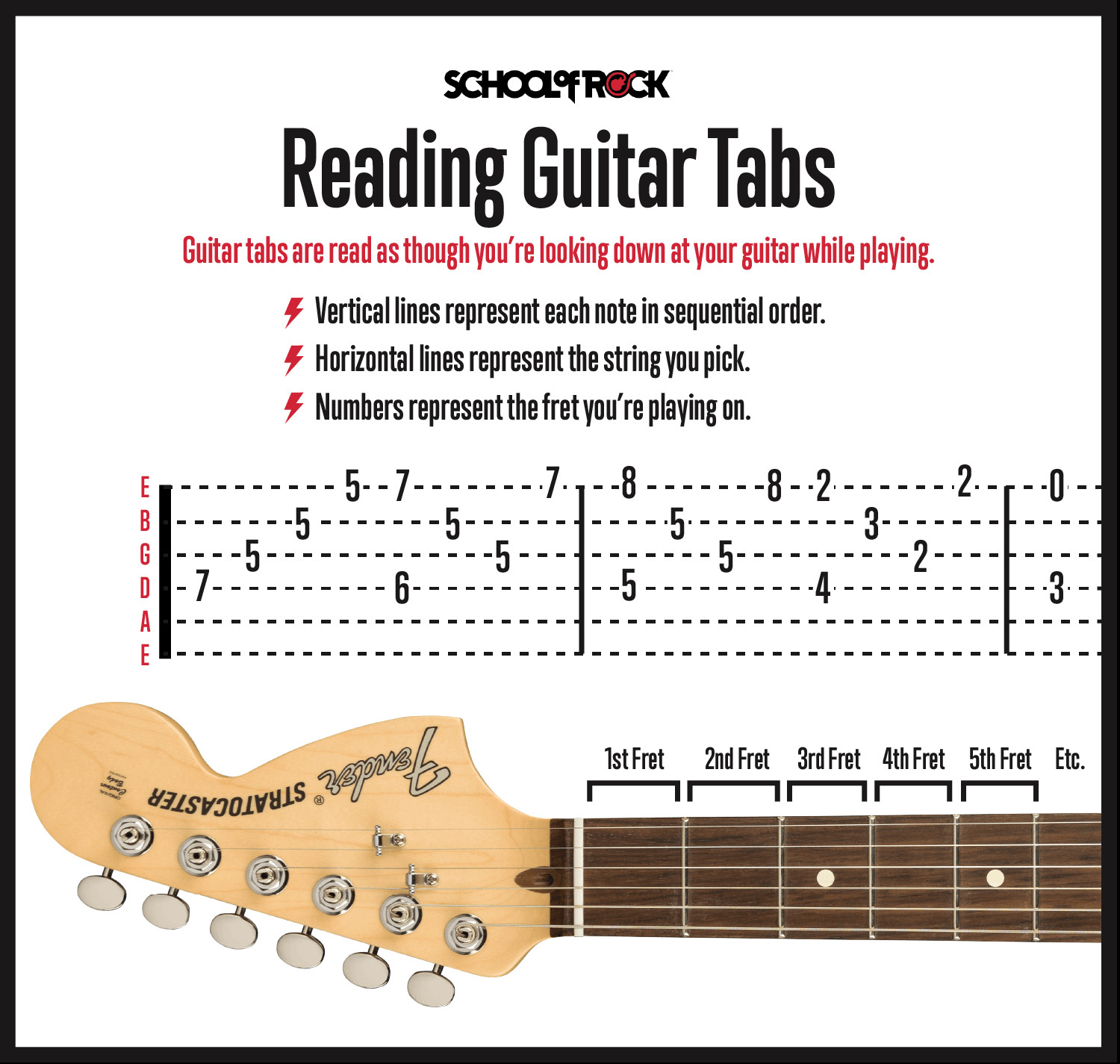 Understanding guitar tabs
Understanding guitar tabs
Within these lines, you’ll find numbers. These numbers represent the frets on your guitar neck – the metal strips running perpendicular to the strings. Frets are numbered from 0 to upwards of 20 (depending on your guitar), starting from the nut (closest to the headstock) down the neck.
A “0” on a string indicates an open string, meaning you play that string without pressing down on any fret. A “1” means you press down at the first fret, “2” at the second fret, and so on. When learning how to read guitar tabs, remember that the numbers always indicate the fret number.
To truly grasp how tabs work, let’s look at an example in action.
HOW TO READ GUITAR TABS EFFECTIVELY
Reading guitar tablature is a left-to-right process, just like reading text. The notes are presented in the order they are played in the song. When you see numbers stacked vertically, one above the other, across multiple lines, it signifies a chord. A chord is played by strumming all the strings indicated simultaneously. For beginners, guitar tab notation is often more intuitive than standard notation because it clearly shows you both the notes of the chord and their location on the guitar.
ESSENTIAL KNOWLEDGE FOR READING GUITAR TABS
To successfully learn how to read guitar tabs, beginners should first become familiar with the names of the 6 guitar strings and the fret positions. This foundational knowledge allows you to quickly translate the tab numbers into actual finger placements on your guitar, effectively using the tab as your guide.
DECODING THE GUITAR TAB STAFF
The guitar tab staff visually resembles the staff used in traditional music notation, but there’s a crucial difference. In guitar tabs, the lines represent the 6 guitar strings, not musical pitches.
The topmost line is always the high E string, and the bottom line is the low E string. This direct string-to-line representation makes learning how to read guitar tabs straightforward for beginners. You’ll often see “TAB” clearly labeled to avoid confusion with standard musical notation.
UNDERSTANDING GUITAR FRETS IN TABS
Guitar frets, the thin metal strips across the fretboard, are the key to navigating tabs.
Most guitars have between 19 and 24 frets. Each fret represents a half step (or semitone) in pitch. Within each octave, there are 12 frets or notes. Many guitars feature fret markers – dots or inlays – on the side of the neck and sometimes on the fretboard itself. These markers, typically located at the 3rd, 5th, 7th, 9th, and 12th frets, are visual aids to quickly identify fret positions while playing.
Remember, in guitar tabs, numbers indicate fretted strings, while “0” signifies an open string. Playing an open string means strumming or picking the string without pressing down on any fret.
READING GUITAR TAB CHORDS
Guitar chords in tabs are easily recognizable not by symbols, but by their arrangement. When multiple numbers are aligned vertically in a column, they represent a chord. These notes are played together, creating a harmonic sound. Even when a chord is arpeggiated – played one note at a time – in tabs, it will appear as a sequence of single notes, even though you are still forming the chord shape with your fretting hand.
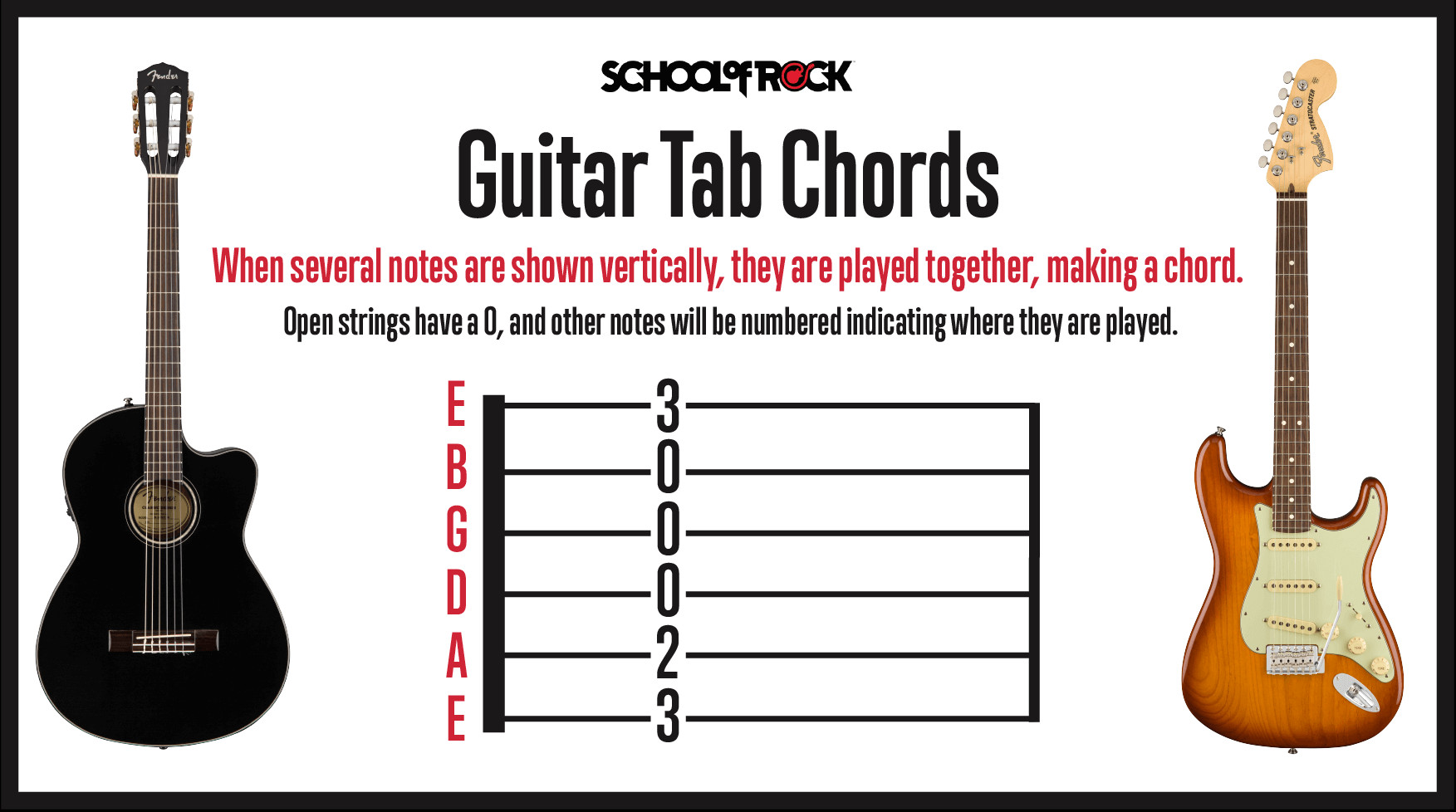 Reading guitar tab chords example
Reading guitar tab chords example
READING GUITAR TAB RIFFS
Many iconic rock songs are built upon “riffs.” Riffs are short, repeating musical phrases, often combining single notes and partial chords, like power chords. When learning how to read guitar tabs for riffs, the same principles apply: vertically aligned notes are played simultaneously. This consistent approach makes understanding guitar tablature efficient and accessible.
GUITAR TABS VS. CHORD CHARTS: WHAT’S THE DIFFERENCE?
Guitar tabs and chord charts serve different but complementary purposes. A chord chart is a visual diagram showing you where to place your fingers on the fretboard to form a specific chord. It often includes finger numbers to guide your hand positioning. Chord charts are frequently placed above song lyrics to indicate chord changes.
However, chord charts only show the essential 3-4 notes of a chord. A complete guitar part often includes single notes, embellishments, or arpeggios that are not represented in a basic chord chart. For this reason, chord charts often accompany guitar tabs, bridging the gap for beginner guitarists and helping them transition from basic chords to playing fuller song arrangements.
UNDERSTANDING FINGER NUMBERS IN CHORD CHARTS
Chord charts utilize a numbering system to indicate which fingers of your fretting hand to use. The index finger is designated as 1, the middle finger as 2, the ring finger as 3, and the pinky finger as 4.
Tabs, on the other hand, use numbers to represent fret numbers, not finger numbers. Therefore, chord charts can be a valuable addition to beginner guitar tabs, providing guidance on hand positioning and finger placement for chords.
EXPERIENCE GUITAR PERFORMANCE ON STAGE
Our guitar programs are led by experienced, practicing musicians who are passionate about teaching. We offer a supportive and dynamic learning environment for all skill levels, with opportunities to perform live on stage and hone your guitar skills.
GUITAR TAB SYMBOLS: BEYOND NUMBERS AND LINES
Beyond the lines and fret numbers, guitar tabs incorporate a variety of symbols to represent specific guitar techniques. Mastering these symbols is crucial for playing with authenticity and expression. Learning how to read guitar tab symbols unlocks a deeper understanding of the nuances of guitar playing.
Before you begin playing, always ensure your guitar tuning is correct. Playing with an out-of-tune guitar will negatively impact your sound.
MUTING TECHNIQUES IN GUITAR TABS
Muting is a fundamental technique, especially in rock and metal genres. Muting adds rhythmic texture and controls unwanted string noise, contributing to a cleaner and more professional sound.
HOW TO PERFORM MUTING
Muting can be achieved with either your picking hand, your fretting hand, or a combination of both. It’s a dynamic technique that adds depth and polish to your playing. Many songs utilize muting in verses and then release the mute for a more open sound in choruses.
Experienced guitarists often incorporate muting instinctively to control string noise, especially at higher volumes, preventing feedback and unwanted sounds.
PALM MUTING TECHNIQUE
Palm muting is a widely used technique in rock guitar. It involves resting the palm of your picking hand lightly on the strings near the bridge while picking. Heavier palm muting creates a tight, percussive sound, while lighter palm muting allows more sustain. In guitar tabs, palm muting is indicated by “P.M.” above the section where it should be applied.
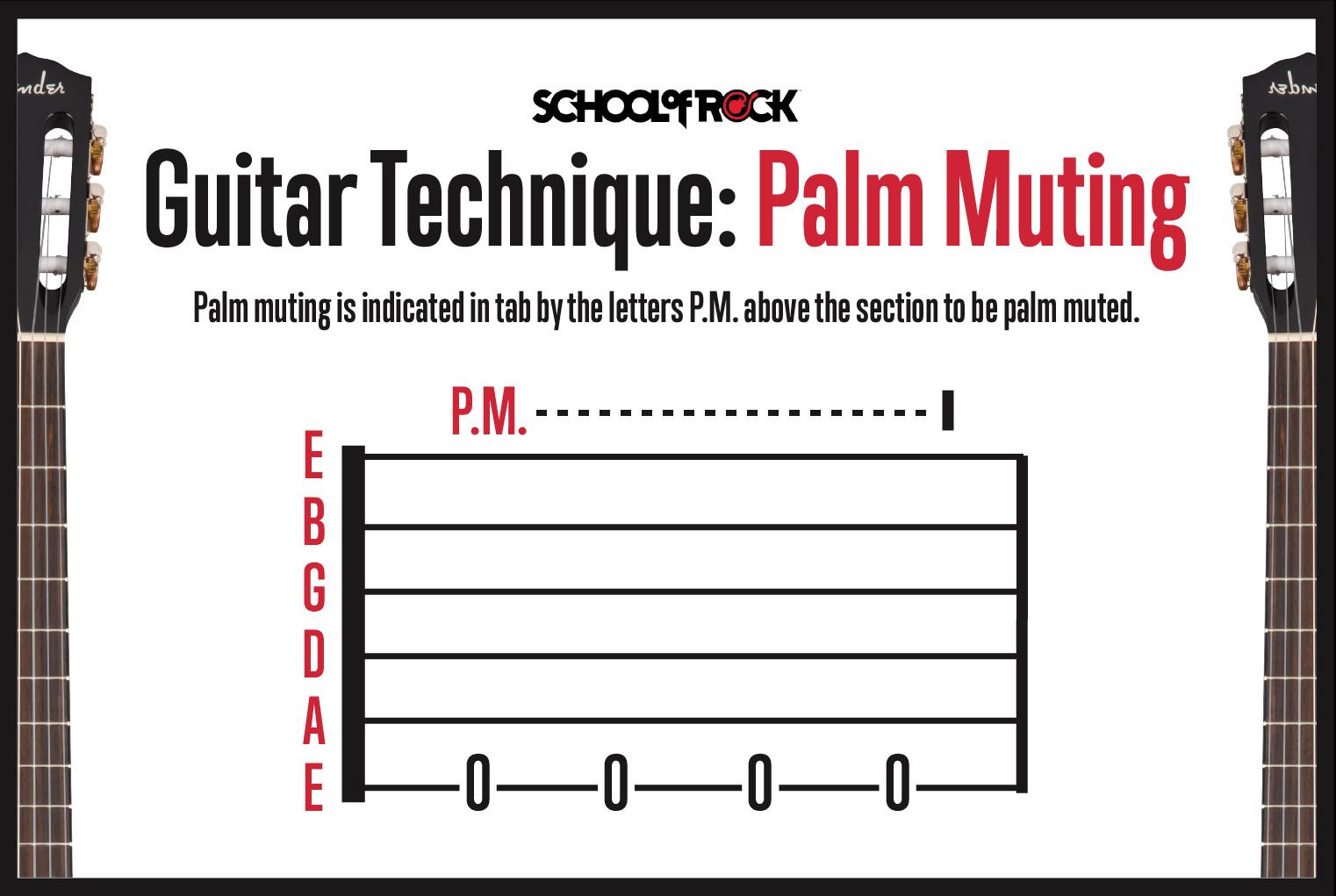 Guitar palm muting technique
Guitar palm muting technique
MUTED NOTES TECHNIQUE
Muted notes are distinct from palm muting. This technique uses your fretting hand to slightly dampen the strings, preventing them from ringing out clearly. In guitar tabs, muted notes are represented by an “X” where a fret number would typically be. You still pick the string, but the fretting hand creates a percussive, muted sound rather than a clear note.
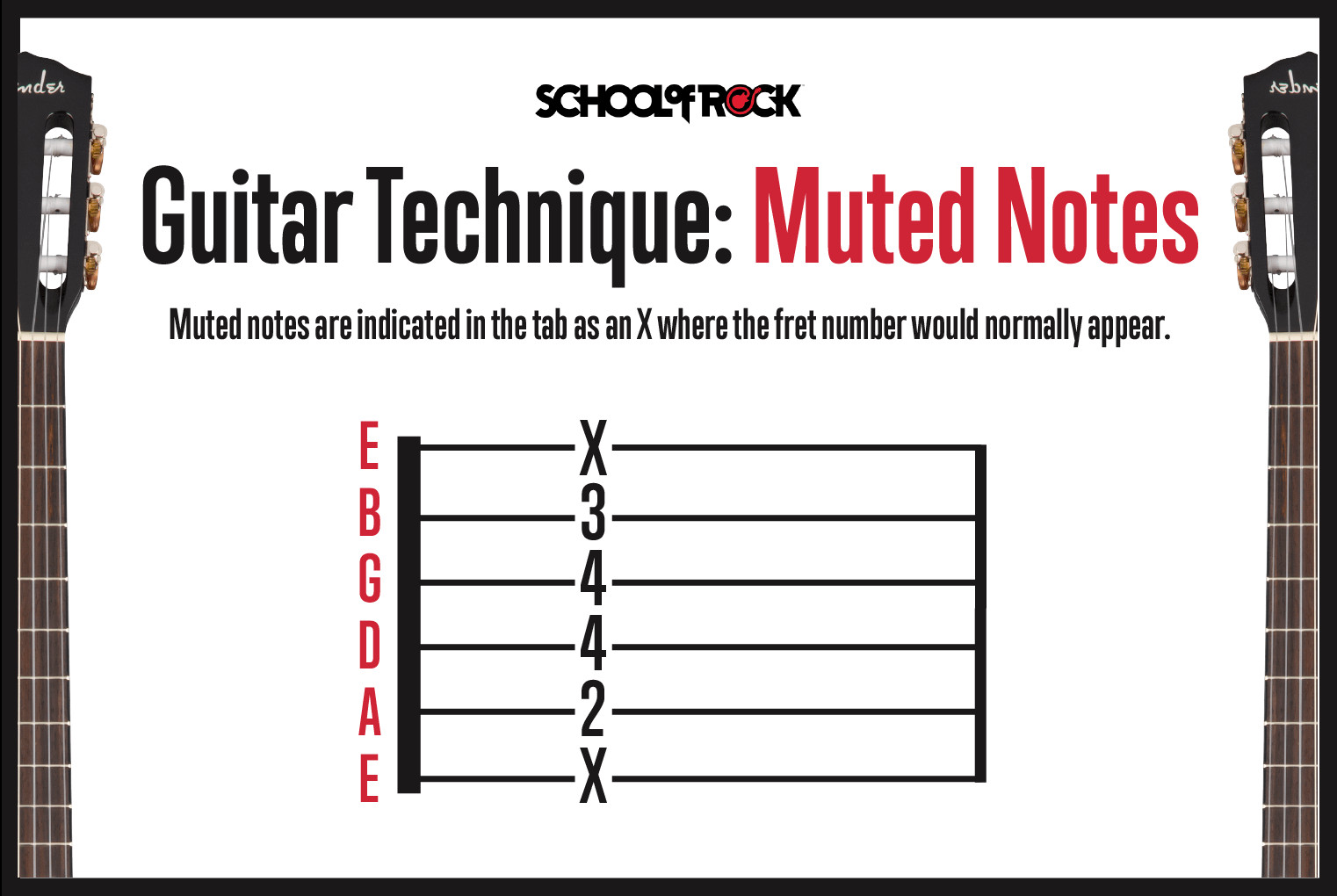 Guitar muted notes technique
Guitar muted notes technique
BENDING GUITAR STRINGS FOR EXPRESSION
String bending is a technique that adds a vocal-like expressiveness to guitar playing. In guitar tabs, bends are indicated by a curved arrow above the note. This arrow signifies that you should bend the string to raise its pitch. The arrow may specify a “½” or “full” step, indicating how much to bend the string – a half step (one fret) or a full step (two frets) higher in pitch. These target pitches are often referred to as “target notes.”
HOW TO BEND STRINGS
Bending is achieved by pushing or pulling the string sideways across the fretboard, rather than pressing straight down. For most strings (except the low E), you typically push upwards towards the ceiling. The low E string is usually bent downwards towards the floor. The key to smooth bends is maintaining consistent pressure while bending.
BENDING TECHNIQUE FOR GUITAR
Most bends are executed using multiple fingers for added strength and control. The primary fretting finger (often the ring finger) is supported by the middle and index fingers. This multi-finger approach makes bending smoother, easier to control, and helps achieve the desired pitch accurately.
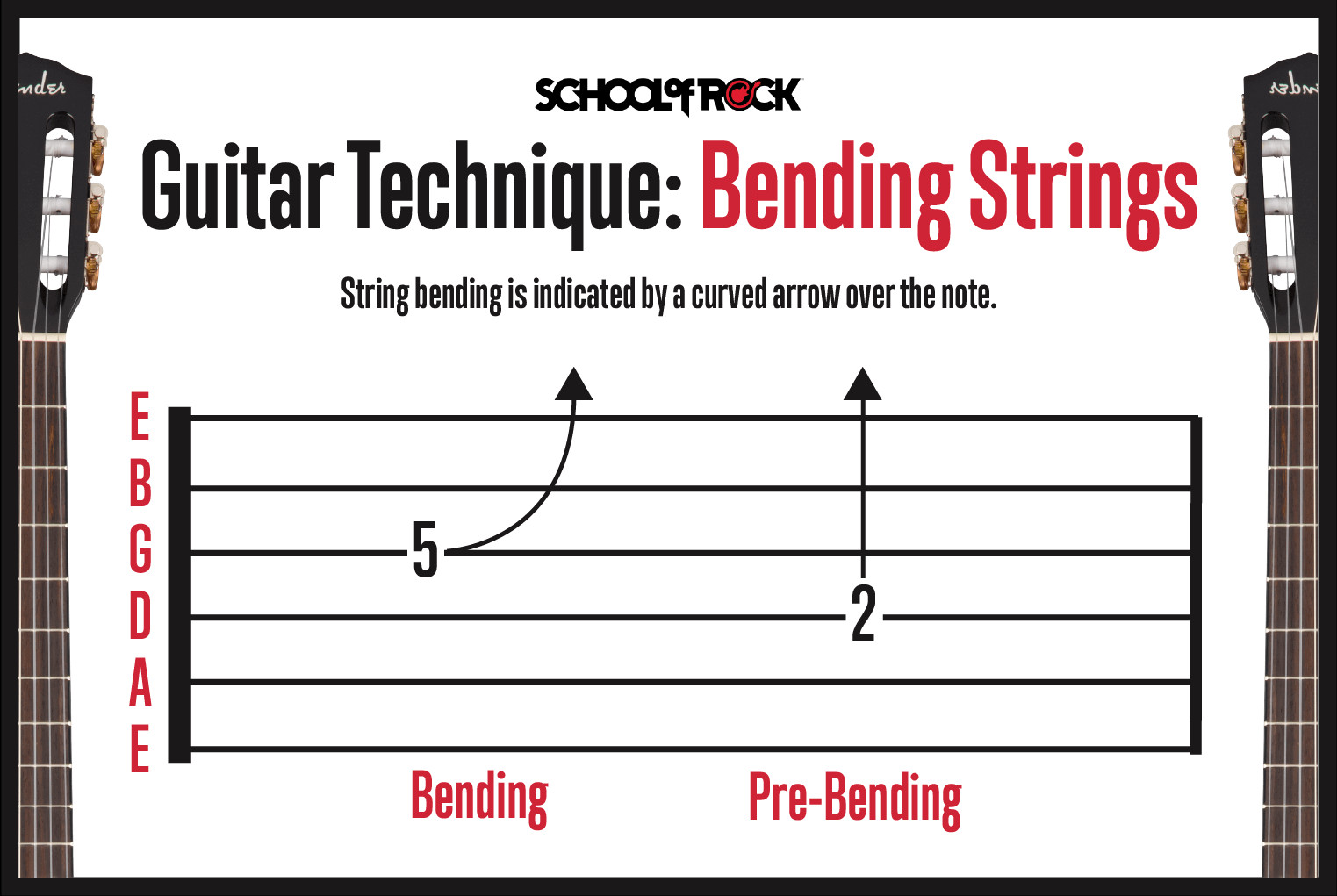 Guitar bending strings technique
Guitar bending strings technique
PRE-BENDING TECHNIQUE
Beginners learning how to read guitar tabs may encounter “pre-bends.” A pre-bend involves bending the string before picking it. The tab notation shows a straight upward arrow with the bend amount (full, ½, etc.), followed by a curved arrow downwards. This indicates that you should bend the string up to the specified pitch, then pick the string and release the bend, allowing it to return to the original fretted note. Pre-bends can also be bent further upwards to reach another target note after the initial release.
SLIDING BETWEEN GUITAR NOTES
Sliding is another essential technique for smooth transitions between notes. You can slide up to a higher note or down to a lower note. Unlike bending, sliding involves moving your fretting finger along the fretboard while maintaining pressure on the string.
SLIDE UP TECHNIQUE
In tabs, a slide up is represented by a line connecting the starting note to the ending note. If the slide is upwards to a higher pitch, the line often slants slightly upwards.
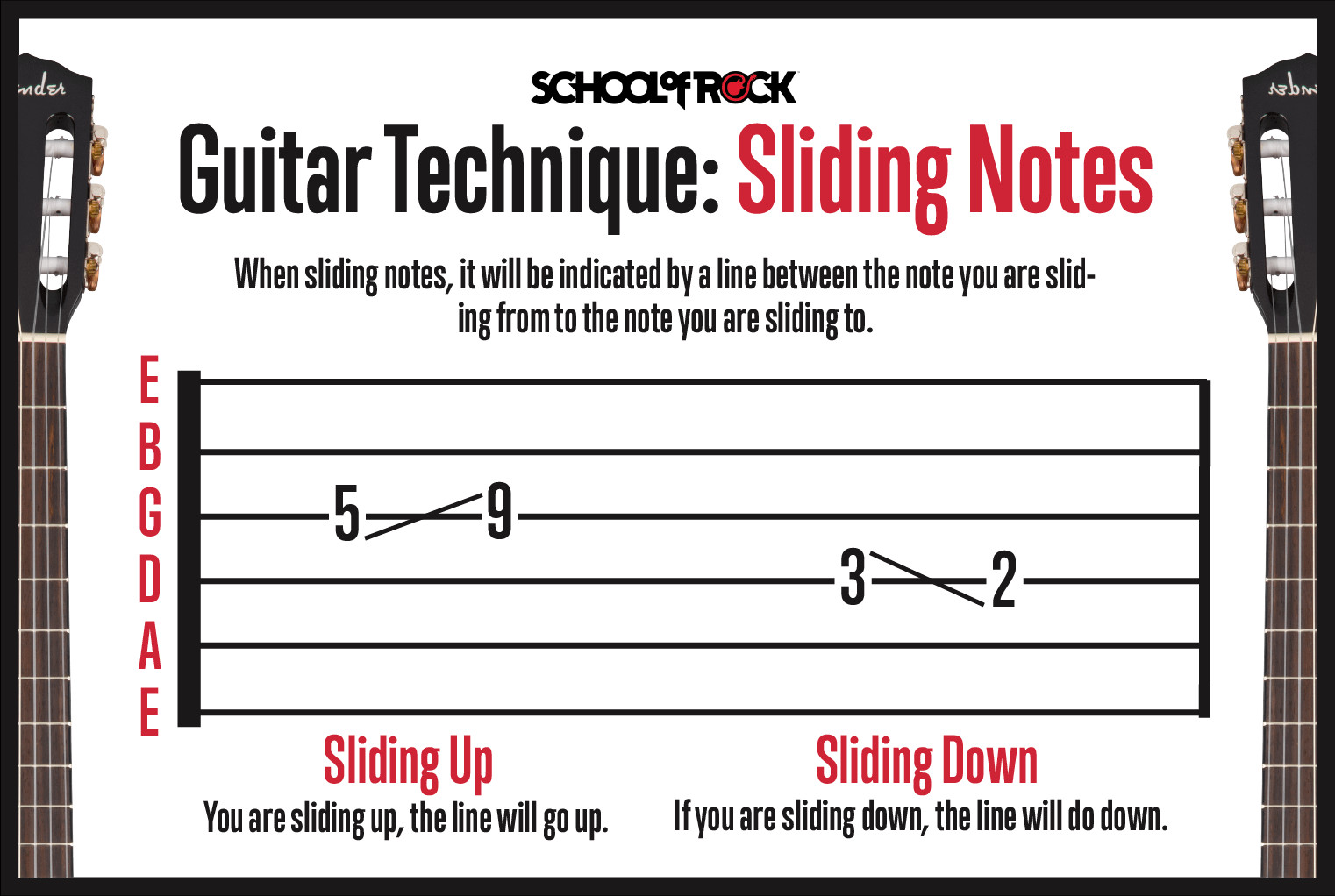 Guitar sliding notes technique
Guitar sliding notes technique
SLIDE DOWN TECHNIQUE
Similarly, a slide down is shown by a line connecting the starting and ending notes. If the slide is downwards to a lower pitch, the line may slant slightly downwards.
HAMMER-ONS ON THE GUITAR
The hammer-on is a technique where you create a note by “hammering” your fretting finger onto the string without picking it. You can hammer-on from an open string or a fretted note, resulting in a higher-pitched note. Hammer-ons are notated in guitar tabs with the letter “H” and an arc connecting the initial note (open or fretted) to the hammered-on note.
HOW TO EXECUTE HAMMER-ONS
To perform a hammer-on, strike the string with your fretting finger with enough force to produce a clear note. This takes practice to develop the necessary finger strength and technique. Electric guitars, especially at higher volumes, often make hammer-ons easier to execute. Practice starting with an open low E string and hammer-on to the third fret, letting the note ring. Repeat this exercise on different strings and frets.
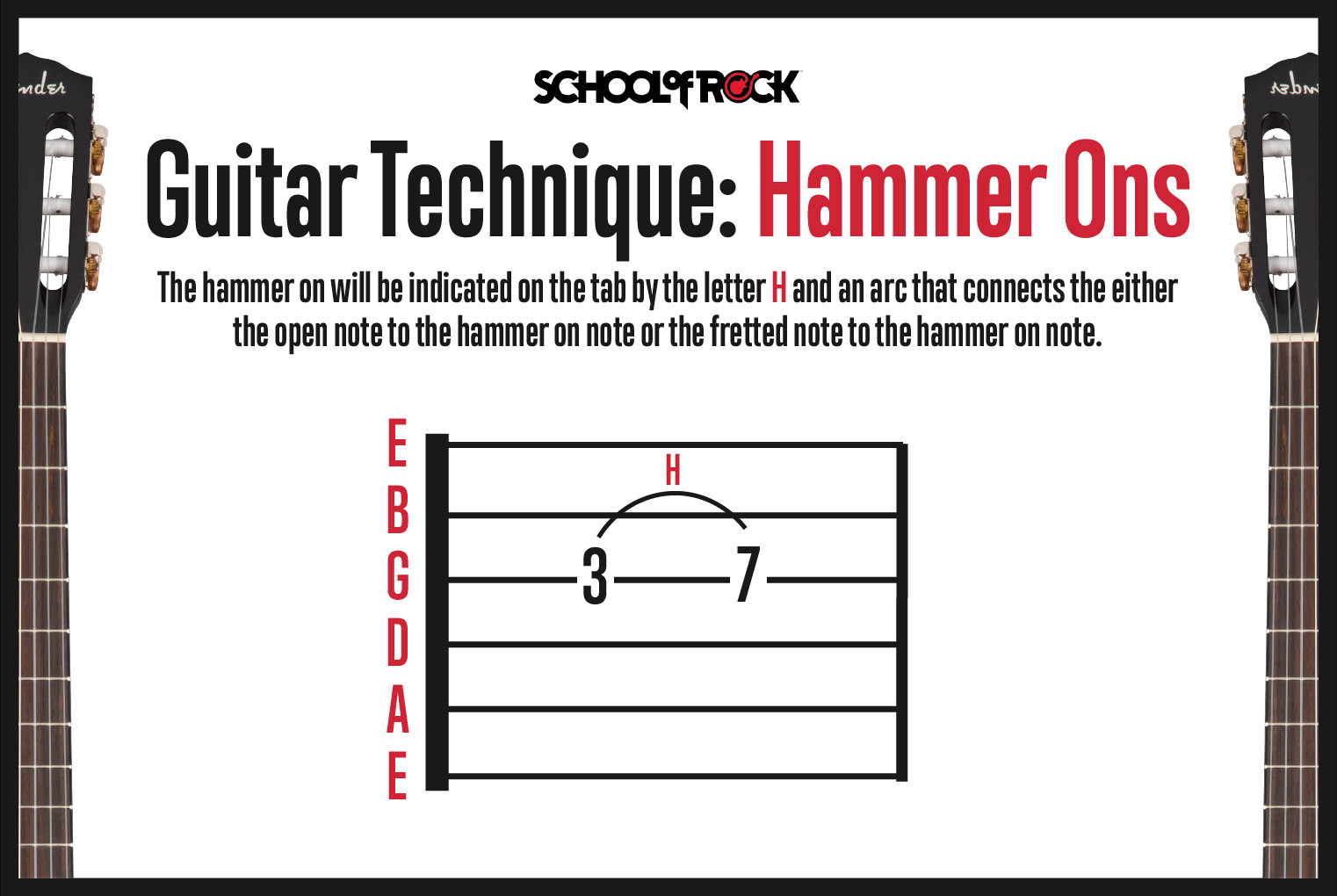 Guitar hammer-ons technique
Guitar hammer-ons technique
PULL-OFFS ON THE GUITAR
Pull-offs are the opposite of hammer-ons. Instead of hammering on, you “pull-off” a fretted finger to sound either an open string or a lower fretted note. Pull-offs are indicated in tabs by the letter “P” and an arc connecting the pulled-off note to the resulting lower note (open or fretted).
HOW TO EXECUTE PULL-OFFS
To perform a pull-off, fret a note, and then pull your finger off the string in a sideways or downward motion, plucking the string as you remove your finger. This action causes the string to vibrate and sound a lower note. When practicing pull-offs, aim to “grab” enough of the string with your fingertip to ensure a clear and ringing note.
Hammer-ons and pull-offs can be combined in alternating sequences to create rapid flurries of notes, often referred to as “trills.”
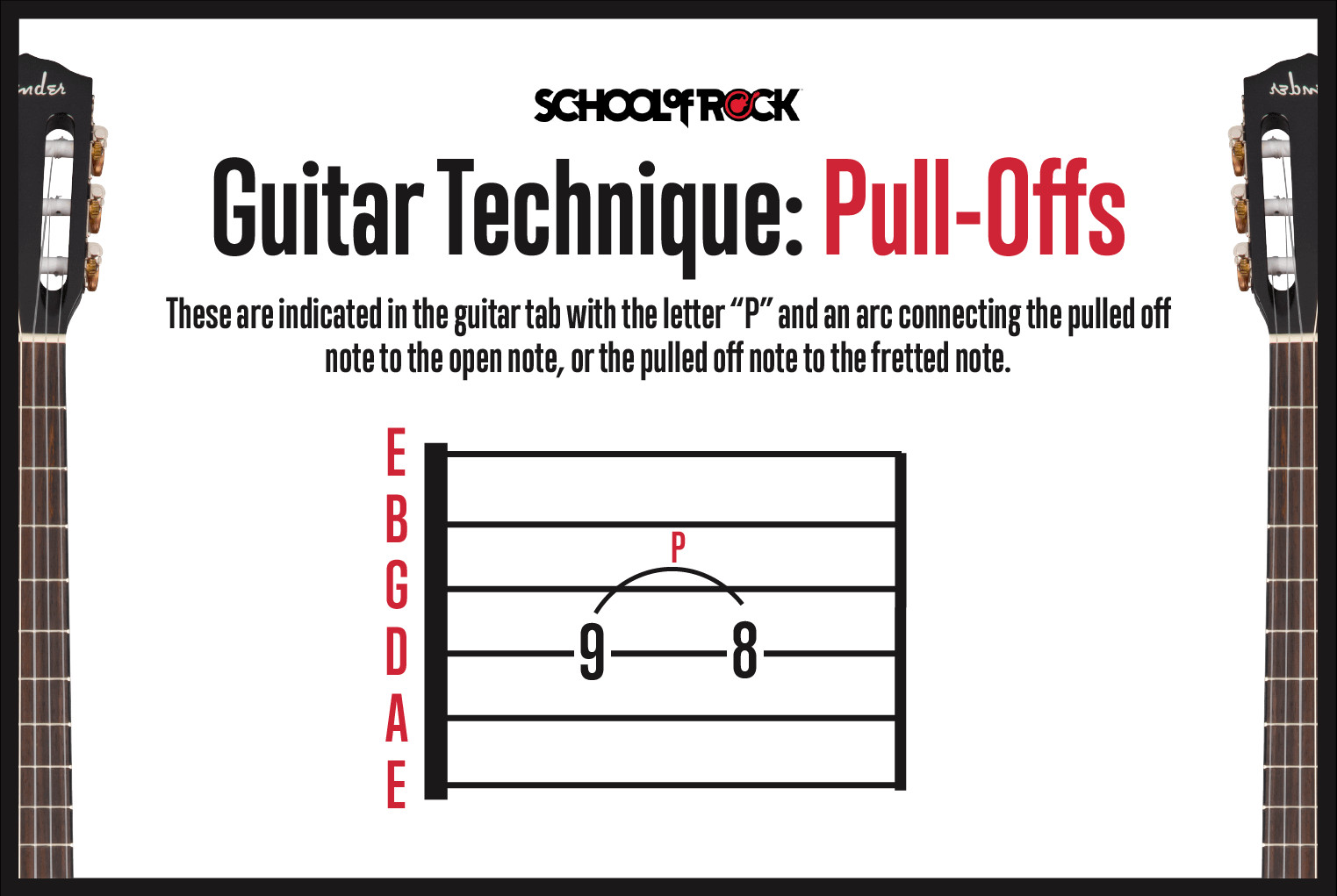 Guitar pull-offs technique
Guitar pull-offs technique
VIBRATO TECHNIQUE
Vibrato is a technique that adds warmth and sustain to notes. It involves subtly and repeatedly bending a note up and down in pitch without fully releasing the fretted position. Vibrato is represented in guitar tabs by a zig-zag line above the staff. The length of the zig-zag line often indicates the duration of the vibrato.
HOW TO PERFORM VIBRATO
Vibrato is similar to bending but with a smaller pitch variation. You can apply vibrato with a single finger or by using multiple fingers for support. Start by practicing slow, smooth vibrato and gradually experiment with different speeds and intensities. Like bending, vibrato is a highly expressive technique, and each guitarist develops a unique vibrato style.
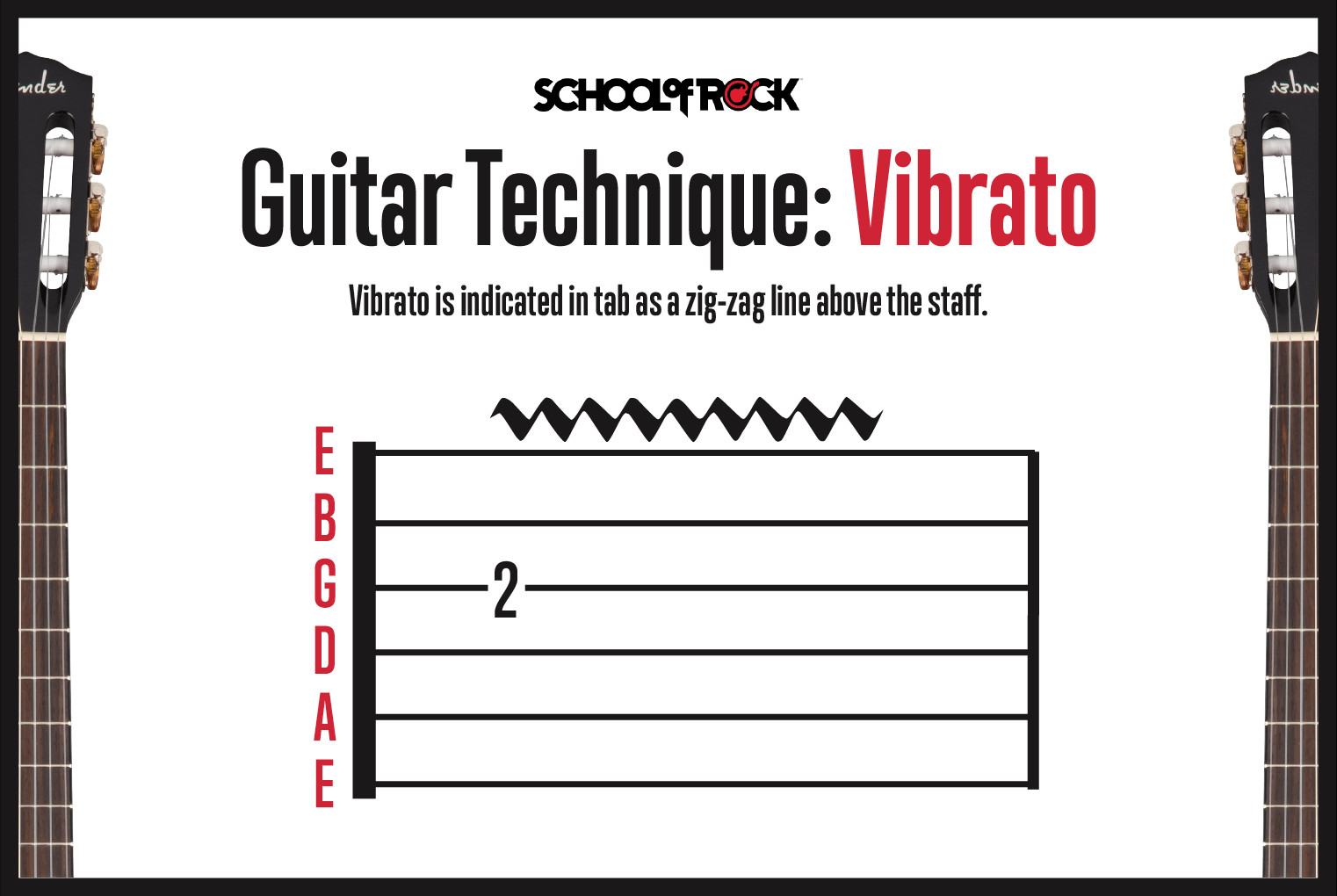 Guitar vibrato technique
Guitar vibrato technique
TAPPING TECHNIQUE ON GUITAR
Tapping is an advanced technique that involves using the fingers of your picking hand to fret notes on the fretboard. Typically, the index finger of the picking hand “taps” or hammers onto the fretboard, creating a note. Tapping is essentially a hammer-on performed with the picking hand. In guitar tabs, tapping is notated with a “T” above the tapped note.
HOW TO FINGER TAP
Tapping was popularized by Eddie Van Halen but has roots in classical guitar. To tap, fret a note with your fretting hand as usual, and then use the index finger of your picking hand to sharply tap a higher fret on the same string. The tapping motion is a variation of a hammer-on, but performed with the picking hand.
Tapping allows you to play notes with wider intervals than possible with just your fretting hand, enabling fast and complex passages. Playing with overdrive or distortion enhances the sustain and clarity of tapped notes. Two-handed tapping further expands possibilities by allowing both hands to independently fret notes.
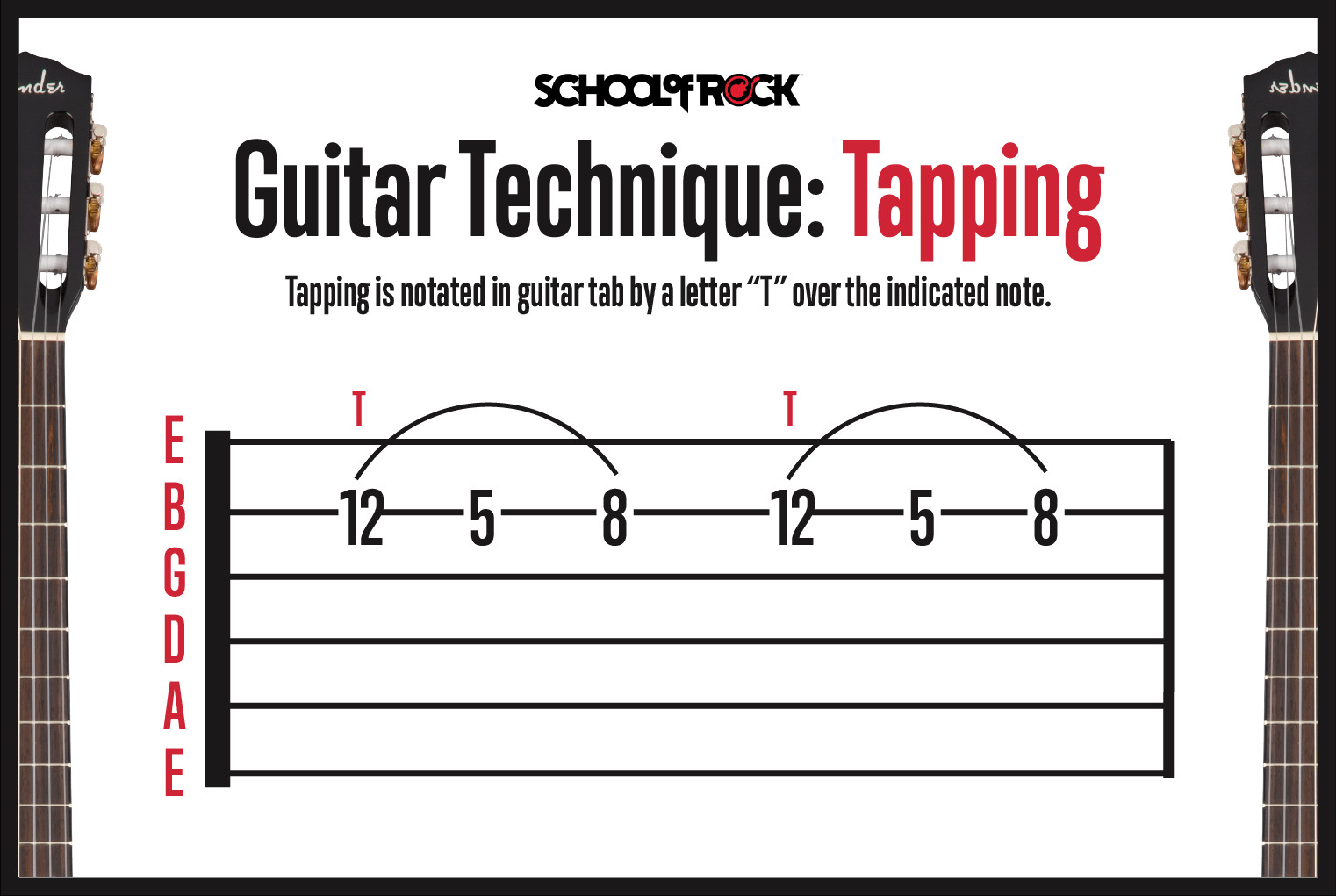 Guitar tapping notes technique
Guitar tapping notes technique
TWO-HANDED TAPPING TECHNIQUE
Two-handed tapping is an advanced technique where both the fretting and picking hands independently tap notes on the fretboard without traditional picking. This often involves the fretting hand tapping bass notes while the picking hand taps melody or solo lines, creating intricate and virtuosic textures.
STRUMMING NOTATION IN GUITAR TABS
When strumming chords, guitar tabs use symbols to indicate downstrokes and upstrokes.
Downstrokes, starting from the lower strings to the higher strings with a downward motion, are represented by a symbol resembling a thick horizontal line with two downward “legs.”
Upstrokes, the opposite, starting from high strings to low strings with an upward motion, are notated by a “V” shaped symbol.
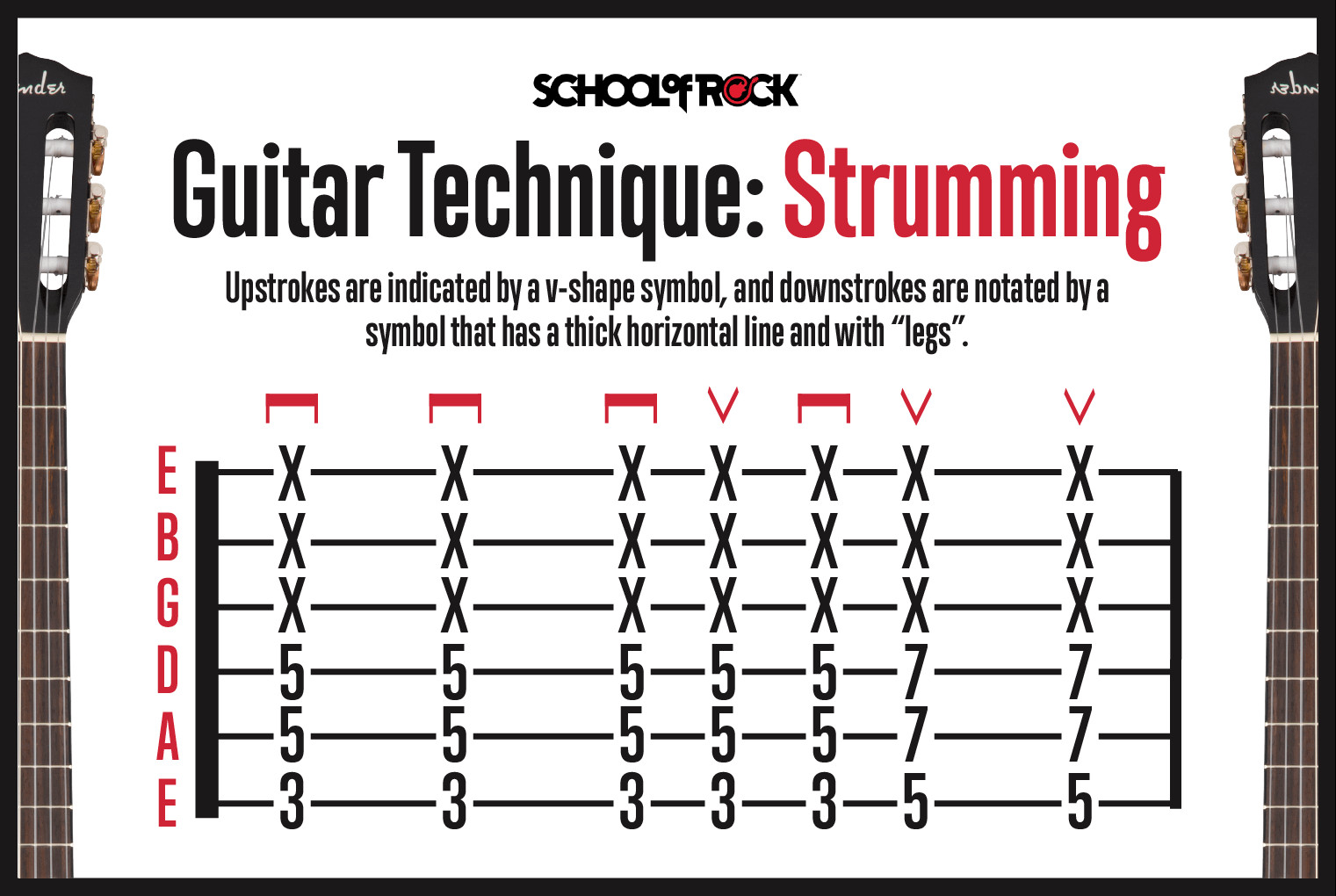 Guitar strumming technique
Guitar strumming technique
HOW TO STRUM EFFECTIVELY
Strumming patterns vary depending on the song’s rhythm. You can use a constant down-up strumming pattern or combine downstrokes and upstrokes in various rhythmic combinations. Eighth-note rhythms, common in many genres, are often counted as “1 and 2 and 3 and 4 and.” Many songs use alternating downstrokes on the numbered beats (1, 2, 3, 4) and upstrokes on the “ands.”
DOWNSTROKES AND UPSTROKES FOR SINGLE NOTES
The same downstroke and upstroke notation applies to single notes in guitar tabs. A downstroke, indicated by the horizontal bar symbol, means picking the note with a downward motion. An upstroke, indicated by the “V” symbol, means picking the note with an upward motion.
READY TO EXPLORE MORE GUITAR TECHNIQUES?
Now that you’ve learned how to read guitar tabs and understand various guitar techniques, you’re well-equipped to start playing! At guitarplayers.net, we are dedicated to helping guitarists of all levels reach their full potential. From basic strumming to advanced tapping, our resources and guides are designed to accelerate your learning and help you play your favorite songs.
Eager to find guitar tabs to practice with? From beginner-friendly songs to challenging pieces for experienced players, guitarplayers.net has you covered. Explore our curated collections of guitar tabs and start playing today!
Thinking about getting a new guitar? Check out our Comprehensive Guitar Buying Guide for expert advice!
